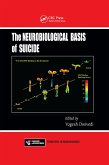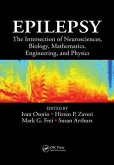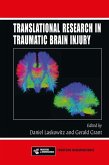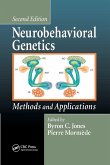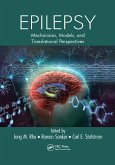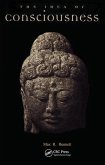Itch
Mechanisms and Treatment
Herausgeber: Carstens, E.; Akiyama, Tasuku
Itch
Mechanisms and Treatment
Herausgeber: Carstens, E.; Akiyama, Tasuku
- Broschiertes Buch
- Merkliste
- Auf die Merkliste
- Bewerten Bewerten
- Teilen
- Produkt teilen
- Produkterinnerung
- Produkterinnerung
Composed of contributions from distinguished researchers around the world, this volume presents a timely update on all aspects of itch research and the clinical treatment of itch that accompanies many dermatological conditions including psoriasis, neuropathic itch, cutaneous t-cells lymphomas, and systemic diseases such as kidney and live
Andere Kunden interessierten sich auch für
![The Neurobiological Basis of Suicide The Neurobiological Basis of Suicide]() The Neurobiological Basis of Suicide92,99 €
The Neurobiological Basis of Suicide92,99 €![Epilepsy Epilepsy]() Epilepsy138,99 €
Epilepsy138,99 €![Translational Research in Traumatic Brain Injury Translational Research in Traumatic Brain Injury]() Translational Research in Traumatic Brain Injury72,99 €
Translational Research in Traumatic Brain Injury72,99 €![Neurobehavioral Genetics Neurobehavioral Genetics]() Neurobehavioral Genetics88,99 €
Neurobehavioral Genetics88,99 €![Epilepsy Epilepsy]() Epilepsy92,99 €
Epilepsy92,99 €![Idea of Consciousness Idea of Consciousness]() Max R BennettIdea of Consciousness85,99 €
Max R BennettIdea of Consciousness85,99 €![Motor Cortex in Voluntary Movements Motor Cortex in Voluntary Movements]() Motor Cortex in Voluntary Movements91,99 €
Motor Cortex in Voluntary Movements91,99 €-
-
-
Composed of contributions from distinguished researchers around the world, this volume presents a timely update on all aspects of itch research and the clinical treatment of itch that accompanies many dermatological conditions including psoriasis, neuropathic itch, cutaneous t-cells lymphomas, and systemic diseases such as kidney and live
Hinweis: Dieser Artikel kann nur an eine deutsche Lieferadresse ausgeliefert werden.
Hinweis: Dieser Artikel kann nur an eine deutsche Lieferadresse ausgeliefert werden.
Produktdetails
- Produktdetails
- Verlag: CRC Press
- Seitenzahl: 496
- Erscheinungstermin: 14. Oktober 2024
- Englisch
- Abmessung: 234mm x 156mm
- Gewicht: 811g
- ISBN-13: 9781032919317
- ISBN-10: 1032919310
- Artikelnr.: 71601722
- Herstellerkennzeichnung
- Libri GmbH
- Europaallee 1
- 36244 Bad Hersfeld
- gpsr@libri.de
- Verlag: CRC Press
- Seitenzahl: 496
- Erscheinungstermin: 14. Oktober 2024
- Englisch
- Abmessung: 234mm x 156mm
- Gewicht: 811g
- ISBN-13: 9781032919317
- ISBN-10: 1032919310
- Artikelnr.: 71601722
- Herstellerkennzeichnung
- Libri GmbH
- Europaallee 1
- 36244 Bad Hersfeld
- gpsr@libri.de
Earl Carstens is Distinguished Professor of Neurobiology, Physiology and Behavior at the University of California, Davis. Dr. Carstens received his B.S. degree in biological sciences from Cornell University and his PhD degree from the University of North Carolina, Chapel Hill, in neurobiology. He conducted postdoctoral research on descending modulation of pain at the University of Heidelberg (Germany) school of medicine and joined the faculty at the University of California, Davis in 1980, where his research interests have focused on somatosensory mechanisms and particularly itch, pain, and chemesthesis. He was awarded Fulbright Senior Professor Research Awards in 1987 and again in 1995. He is currently vice president of the International Forum for the Study of Itch. Dr. Carstens has coauthored numerous research articles, book chapters, and reviews on itch, pain, chemesthesis, and mechanisms of anesthetic action. Tasuku Akiyama is an assistant project scientist at the University of California, Davis. Born in Yamaguchi, he received his PhD in pharmacology at Toyama University. From 2008 to 2012, he was a postdoctoral fellow at the University of California, Davis, where he is currently an assistant project scientist. Dr. Akiyama's research focuses on the investigation of neuronal mechanisms of itch and pain. His published work includes studies on the spinal and trigeminal processing of itch and pain, the neuronal mechanisms of itch in mosquito bite and dry skin, and the mechanisms of itch sensitization under chronic itch conditions.
Itch Hypotheses: From Pattern to Specificity and to Population Coding.
Epidemiology of Itch. Atopic Dermatitis. Clinical Aspects of Itch:
Psoriasis. Pruritus in Renal Disease. Pruritus of Cholestasis. Neuropathic
Itch. Pruritus in Cutaneous T-Cell Lymphomas. Pruriceptors. Peripheral
Neuronal Mechanism of Itch 1: Histamine and Itch. Role of PAR-2 in
Neuroimmune Communication and Itch. Mrgprs as Itch Receptors. Role of
Interleukin-31 and Oncostatin M in Itch and Neuroimmune Communication.
Toll-Like Receptors and Itch. Lipid Mediators and Itch. The Role of
Transient Receptor Potential Channels in Acute and Chronic Itch.
Sensitization of Itch Signaling 2: Itch Sensitization-Nerve Growth Factor,
Semaphorins. Peripheral Opioids. Spinal Coding of Itch and Pain. Spinal
Microcircuits and the Regulation of Itch. Itch Modulation by
VGLUT2-Dependent Glutamate Release from Somatic Sensory Neurons. Ascending
Pathways for Itch. The Brain Processing of Itch and Scratching. Central
Nervous Processing of Itch and Pain. Roles of Central Opioid Receptor
Subtypes in Regulating Itch Sensation. Sensitization for Itch. Index.
Epidemiology of Itch. Atopic Dermatitis. Clinical Aspects of Itch:
Psoriasis. Pruritus in Renal Disease. Pruritus of Cholestasis. Neuropathic
Itch. Pruritus in Cutaneous T-Cell Lymphomas. Pruriceptors. Peripheral
Neuronal Mechanism of Itch 1: Histamine and Itch. Role of PAR-2 in
Neuroimmune Communication and Itch. Mrgprs as Itch Receptors. Role of
Interleukin-31 and Oncostatin M in Itch and Neuroimmune Communication.
Toll-Like Receptors and Itch. Lipid Mediators and Itch. The Role of
Transient Receptor Potential Channels in Acute and Chronic Itch.
Sensitization of Itch Signaling 2: Itch Sensitization-Nerve Growth Factor,
Semaphorins. Peripheral Opioids. Spinal Coding of Itch and Pain. Spinal
Microcircuits and the Regulation of Itch. Itch Modulation by
VGLUT2-Dependent Glutamate Release from Somatic Sensory Neurons. Ascending
Pathways for Itch. The Brain Processing of Itch and Scratching. Central
Nervous Processing of Itch and Pain. Roles of Central Opioid Receptor
Subtypes in Regulating Itch Sensation. Sensitization for Itch. Index.
Itch Hypotheses: From Pattern to Specificity and to Population Coding.
Epidemiology of Itch. Atopic Dermatitis. Clinical Aspects of Itch:
Psoriasis. Pruritus in Renal Disease. Pruritus of Cholestasis. Neuropathic
Itch. Pruritus in Cutaneous T-Cell Lymphomas. Pruriceptors. Peripheral
Neuronal Mechanism of Itch 1: Histamine and Itch. Role of PAR-2 in
Neuroimmune Communication and Itch. Mrgprs as Itch Receptors. Role of
Interleukin-31 and Oncostatin M in Itch and Neuroimmune Communication.
Toll-Like Receptors and Itch. Lipid Mediators and Itch. The Role of
Transient Receptor Potential Channels in Acute and Chronic Itch.
Sensitization of Itch Signaling 2: Itch Sensitization-Nerve Growth Factor,
Semaphorins. Peripheral Opioids. Spinal Coding of Itch and Pain. Spinal
Microcircuits and the Regulation of Itch. Itch Modulation by
VGLUT2-Dependent Glutamate Release from Somatic Sensory Neurons. Ascending
Pathways for Itch. The Brain Processing of Itch and Scratching. Central
Nervous Processing of Itch and Pain. Roles of Central Opioid Receptor
Subtypes in Regulating Itch Sensation. Sensitization for Itch. Index.
Epidemiology of Itch. Atopic Dermatitis. Clinical Aspects of Itch:
Psoriasis. Pruritus in Renal Disease. Pruritus of Cholestasis. Neuropathic
Itch. Pruritus in Cutaneous T-Cell Lymphomas. Pruriceptors. Peripheral
Neuronal Mechanism of Itch 1: Histamine and Itch. Role of PAR-2 in
Neuroimmune Communication and Itch. Mrgprs as Itch Receptors. Role of
Interleukin-31 and Oncostatin M in Itch and Neuroimmune Communication.
Toll-Like Receptors and Itch. Lipid Mediators and Itch. The Role of
Transient Receptor Potential Channels in Acute and Chronic Itch.
Sensitization of Itch Signaling 2: Itch Sensitization-Nerve Growth Factor,
Semaphorins. Peripheral Opioids. Spinal Coding of Itch and Pain. Spinal
Microcircuits and the Regulation of Itch. Itch Modulation by
VGLUT2-Dependent Glutamate Release from Somatic Sensory Neurons. Ascending
Pathways for Itch. The Brain Processing of Itch and Scratching. Central
Nervous Processing of Itch and Pain. Roles of Central Opioid Receptor
Subtypes in Regulating Itch Sensation. Sensitization for Itch. Index.


